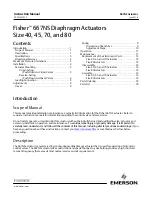
Instruction Manual
D102603X012
667NS Actuator
June 2018
11
3. For sizes 40 through 70, turn the spring adjustor (key 74, figure 2 or 3) into the yoke to shift the span up or turn the
spring adjustor out of the yoke to shift the span down. For size 80, remove the cap screw (key 91, figure 4) and
remove the adjusting screw cover (key 84); then rotate the spring adjustor (key 74) to shift the span. Replace the
cover and cap screw when adjustment is complete.
If the actuator has a side‐mounted handwheel assembly (manual actuator), clockwise handwheel rotation closes the
valve.
For successful operation, the actuator stem and valve plug stem must move freely in response to the loading pressure
change on the diaphragm.
Operation
In a reverse‐acting diaphragm actuator, an increasing loading pressure causes the actuator stem to move upward,
compressing the spring. When the diaphragm pressure is decreased, the spring moves the actuator stem downward.
This is shown graphically in figure 1. In the event of failure of the loading pressure to the diaphragm of the actuator,
the actuator stem moves to the extreme downward position. Thus, by the proper selection of the valve plug action,
either push‐down‐to‐close or push‐down‐to‐open, the control valve will either close or open on failure of the
diaphragm loading pressure.
The nameplate attached to the yoke of the actuator provides information about the specific construction and
operating range. The spring and diaphragm have been selected to meet the requirements of the application, and in
service, the actuator should create full travel of the valve plug when the diaphragm pressure (operate) range indicated
on the nameplate is applied. This diaphragm pressure range is generally 0.2 to 1.0 bar or 0.4 to 2.0 bar (3 to 15 psi or 6
to 30 psi).
Pressure in the valve body creates a force on the valve plug that has a direct effect on the actual operating diaphragm
pressure range. In some instances, the valve may not stroke completely over the indicated range because the pressure
conditions in the body are different from those for which the control valve has been set at the factory. A simple spring
adjustment, however, may be all that is required to obtain correct travel for the diaphragm pressure range utilized.
Note that the actuator spring has a fixed pressure span and that adjustment of the spring compression merely shifts
this span up or down to make valve travel coincide with the diaphragm pressure range.
The nameplate specifies a bench set pressure range in addition to a diaphragm pressure (operate) range. The bench
set range is that pressure range required to stroke the valve fully without any pressure in the body, as would be the
case if the valve were set on the work bench. However, in service with the specified pressure drop applied across the
valve, it should stroke over that diaphragm pressure (operate) range indicated on the nameplate.
When the control valve and actuator are installed, the actuator should be checked for correct travel, freedom from
excessive friction, and correct action (air‐to‐open or air‐to‐close) to match the controlling instrument. For successful
operation, the actuator stem and valve plug stem must move freely in response to the loading pressure change on the
diaphragm.
Maintenance
Normally, only the elastomeric parts and the spring of the 667NS actuator require inspection or replacement. The
maintenance instructions are divided into three subsections: Replacement of Elastomeric Parts, Disassembly, and
Assembly. Perform only those steps applicable to the actuator size and required maintenance.
It is recommended that the diaphragm and all of the other elastomeric parts of the 667NS actuator be inspected every
two years. The absolute maximum replacement period for any of the elastomeric parts is four years.










































